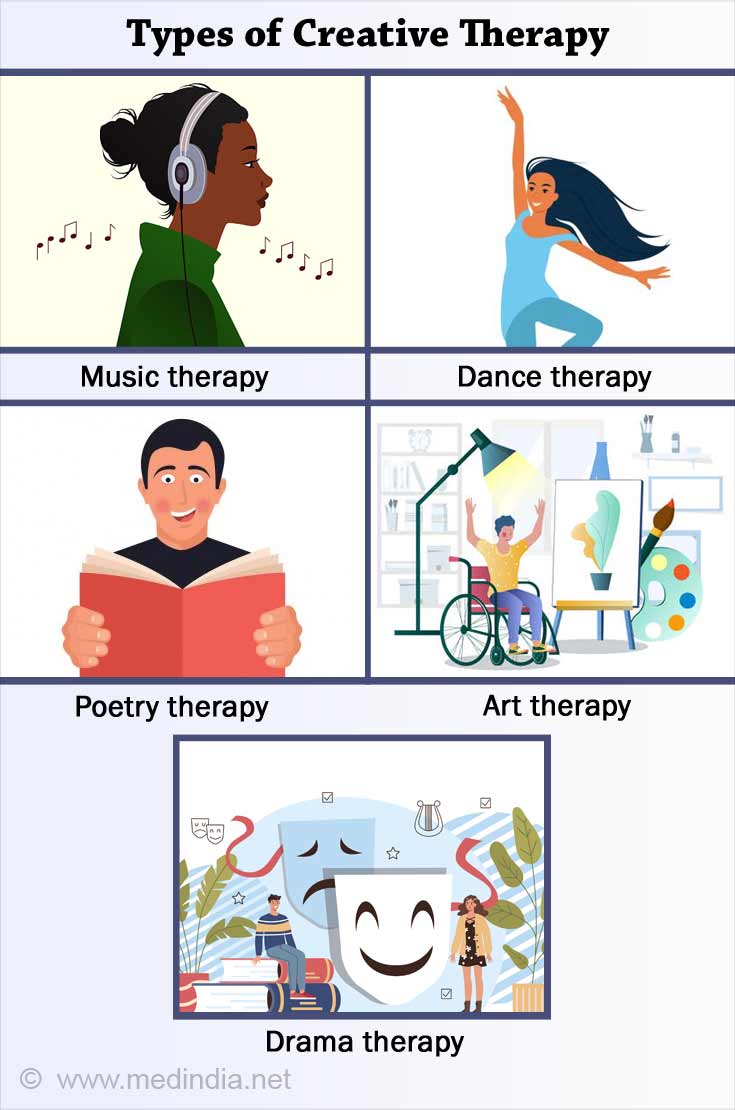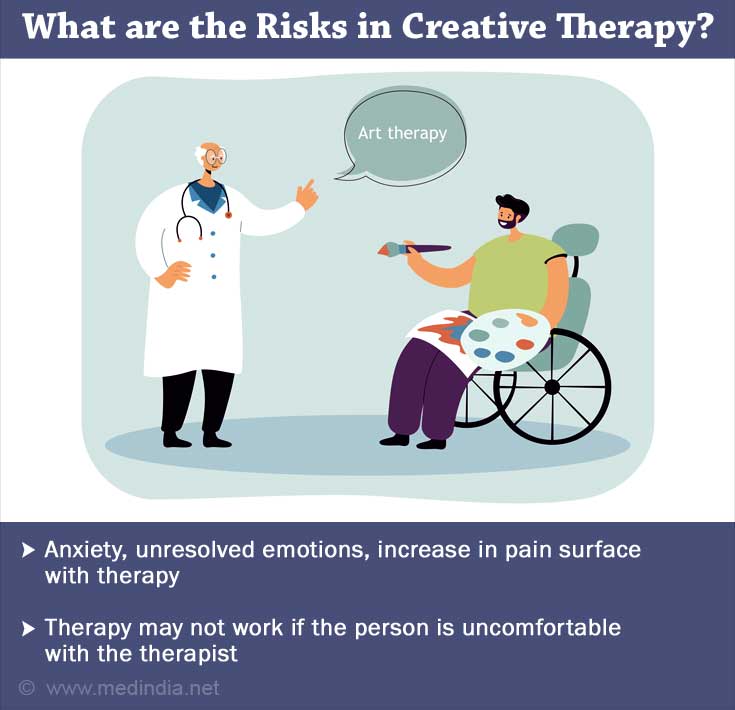- Creative Therapies - (https://www.takingcharge.csh.umn.edu/creative-therapies)
- What is Creative Therapy? - (https://www.creativetherapy.org.uk/creative.html)
- About Creative Therapy - (https://childrenandfamilyhealthdevon.nhs.uk/camhs/articles/3237-2/)
- Creative therapies for adults - (https://www.researchgate.net/publication/285885723_Creative_therapies_for_adults)
- The important connection between creativity and therapy - (https://www.counselling-directory.org.uk/memberarticles/the-important-connection-between-creativity-therapy)
- Creative therapy support roles - (https://www.healthcareers.nhs.uk/explore-roles/wider-healthcare-team/roles-wider-healthcare-team/clinical-support-staff/creative-therapy-support-roles)
- Helping You Creatively Change in Lives - (https://www.artandplaytherapytraining.com.au/)
- Creative Arts Therapy - (https://mymind.org/creative-arts-therapy)
- The State of the Art in Creative Arts Therapies - (https://www.frontiersin.org/articles/10.3389/fpsyg.2020.00068/full)
- Art Therapy - (https://www.goodtherapy.org/learn-about-therapy/types/art-therapy)
- Creative Therapy for Children and Young People - (https://www.creativetherapyforcayp.co.uk/)
Creative Therapy
Creative therapy does work as a form of therapy which encourages and enables a person to work through their issues making use of art-based exercises.
Creative therapy uses art forms such as dance, drawing, or music to help treat certain mental conditions especially the emotional conditions. It is the trained therapists who use creative therapy in helping people who do experience a subtle range of the mental, emotional, and sometimes even physical issues.
Creative therapy does not mandate a person to have any special artistic ability for execution. Creative therapy helps a person channelize their thoughts, emotions, and feelings by way of an artistic expression. Creative therapy is very useful for people who do have a difficulty expressing their feelings verbally.
For example, once a person has created a piece of art, they can move to discuss their choices with the therapist. Talking with a therapist about their creation helps the person process exactly how they are feeling.
Creative Therapy - Types, Techniques & Benefits
Various types of creative therapy do benefit a person. Certain creative therapies are far more useful towards specific conditions. Speaking with a therapist to determine which type of creative therapy works best for a person is good.
Alternatively, a person may progress to find what has drawn them towards a particular form of creative therapy. The person may wonderfully discover that they benefit from drawing or sculpting at home. However, that will not have the involvement of a therapist in looking at the creations.
The section below entails the various types of creative therapy.

1. Music Therapy: In music therapy, a trained music therapist does use musical responses towards assessing a person’s physical and emotional well-being.
A music therapy session does involve the following techniques:
Drumming, learning music-assisted relaxation techniques, such as progressive muscle relaxation or deep breathing, playing instruments, such as hand percussion, writing song lyrics, learn to play a piano or a guitar, discussing the emotional reaction or improvization.
Benefits of Music Therapy
Music helps a person relax and more so process emotions. Music therapy is highly useful for people of all ages. Music therapy enables people with developmental or physical disabilities, Alzheimer’s disease, substance misuse issues, brain injuries, acute or chronic pain which happen to include labor-related pain and mental health conditions.
People with mild-to-moderate Alzheimer’s disease do have improved memory, orientation, depression, and anxiety levels by way of following music therapy sessions. It is indicated that listening to music such as classical music combined with jazz does have a positive effect on people with depression and anxiety.
2. Dance Therapy: Dance therapy does involve the use of movement to enhance a person’s cognitive, emotional, social, and physical well-being.
Techniques of dance therapy include mirroring, visible movement analysis, non-verbal metaphors, impactful imaginative techniques, meditative techniques, introspection, and immense focusing.
Dance therapists involve the following benefits:
Create options for dealing with problems discover the reasons for the patterns of behavior, expand their movement levels, improve their self-esteem plus body image, develop better communication skills, and build better relationships
Dance therapy is useful towards people who do have developmental, medical, social, physical, or psychological issues.
The use of dance therapy may be highly beneficial for adults with depression. Dance therapy does decrease the anxiety and depression levels while it also happens to increase cognitive skills, and thereby the quality of life.
3. Poetry Therapy: In a poetry therapy it is a therapist who uses the reading or writing of poetry in helping a person understand their feelings and those of others. Poetry therapy is very useful when treating cancer. A study published in International Journal of Cancer Managementrevealed group poetry therapy can be a good psychotherapy way to boost the quality of life of patients with breast cancer. It is seen through poetry sessions a person can express their thoughts and emotions, and that poetry helps them feel like part of a community.
The techniques of poetry therapy:
The receptive/prescriptive component: In this form, the therapist introduces famous poems. Reading poem reacting in a way relates to the subject in return. A personalized, feeling response is encouraged.
The expressive/creative component: This component involves the use of creative writing. It can even be poetry, letters, and may be the journal entries that do help the therapist to gain deeper insight. It does allow to free up the blocked emotions or buried memories.
The symbolic/ceremonial component: This is where metaphors and storytelling come in. It does help individuals in explaining complex emotions. It offers a creative outlet for people who enjoy artistic expression making it an addition to traditional therapy.
Benefits of Poetry Therapy
Poetry allows people to express themselves and their feelings. The struggle is about directly sharing the feelings which make the metaphors of poetry as a process easier.
Poetry helps people with complex neurological issues as they feel less alone. For example, people with schizophrenia can give voice to their several experiences through poetry.
Poetry can help educate the common emotions and communication issues. It encourages people to open.
Poetry gives people a chance towards exploring the challenging existential issues. For example, the therapists use poetry for those who are dying, living in nursing homes, or even facing other life changing experiences.
4. Art Therapy: Art therapy makes use of drawing, painting, collage, coloring, or sculpting as the creative techniques to express themselves artistically and then proceed to examine the psychological and emotional undertones in their art. Decoding the nonverbal messages, symbols, and metaphors takes place. A better understanding of the feelings and behavior do resolve the deeper issues.
Art therapy involves techniques encompassing various art forms such as painting, drawing, or even sculpting to help a person-reduce anxiety, enhance the reality orientation, increase self-esteem, explore feelings, reconcile with emotional conflicts, manage the behavior, promote one’s self-awareness and develop social skills. These are the emotional benefits of art therapy.
The physical benefits of art therapy:
- Decreases symptoms of stress
- Improves the quality of life in adult cancer patients
- Improves ability to deal with pain in children with cancer
- Reduces the stress and anxiety in children with asthma
- Stimulates the mental function in the older adults with dementia
- Indicates a reduction towards the depression in Parkinson's patients
An art therapist can look at a piece that a person has created and then help them discuss the feelings involved in that creation. The act of creating art does help soothe and more so relax a person.
5. Drama Therapy provides a person with a suitable platform for sharing one’s thoughts, emotions, and feelings.
The therapeutic goals of drama therapy do take many forms and include a range of techniques such as drama exercises, enactment, improvizations, puppetry, role play, storytelling, and theater games.
Drama therapy is highly useful for people of all ages, and it is particularly beneficial for older adults, ones receiving treatment for behavioral health issues, recovering from an addiction, do have a “dysfunctional” family, been to prison, been without a home, do have HIV or AIDS, deal with developmental disabilities, ones who have experienced trauma, have mental health conditions.
Drama therapy has a positive effect on the self-perception and self-expression of people with mental health or behavioral conditions.
Drama therapy can be beneficial in many ways, including helping people to feel less isolated, learn how to solve problems, express how they're feeling, set goals, relate better to other people, understand the experiences of people clearly, improve self-esteem and self-worth, develop better coping skills at home, school, and/or work, broaden the range of expression of emotion, use creativity, imagination, and play to practice reacting to difficult situations, get to the point of addressing problems quickly, escape from the pressures of life into the imagination for a little while, interactions in a safe, comfortable environment
Risks in Creative Therapies
Certain people experience anxiety, an increase in pain, and even unresolved emotions surface with creative therapy. That is why it is important to have qualified creative therapists administering creative therapy.

This fully ensures that a person does receive the treatment that they necessarily need.
The therapies rely on the person being able to engage in a creative activity. Not feeling comfortable in working with a therapist indicates that creative therapy may not be ideal for them.
How can Creative Exercises Prove to be Beneficial?
There are many conditions in which a person can benefit from the use of creative therapy.
- People can use creative therapy to encourage complete insight into situations that are causing issues, resolving conflict or say distress, improving the cognitive and sensorimotor functions, improvingself-esteem and self-awareness, enhancing the social skills, and building on the emotional strength.
- Creative therapy can be useful for providing a distraction from pain or any form of illness, giving a person a complete sense of personal achievement, helping a person have a better understanding towards themselves, providing complete relaxation or empowerment, helping a person build-up a relationship.
- Creative therapy does help treat trauma, stress, mental health conditions, Alzheimer’s disease, dementia, chronic illnesses, such as cancer, head injuries, substance misuse issues, physical or developmental disabilities.
- This makes creative therapy a resolve to help people experiencing stress. It is observed taking part in creative therapy does significantly reduce a person’s stress levels. Creative therapy does have various positive impacts on people with cancer, dementia, HIV or AIDS and heart failure.
Summary
Creative therapy involves a person receiving treatment through art-based activities. Creative therapy is useful for people with the physical, mental, and even emotional conditions and it also several benefits.
There are many forms of creative therapy, each of which provide treatment in different ways. Getting in touch with a healthcare professional about the types of creative therapy which suits them best is a core essential.









